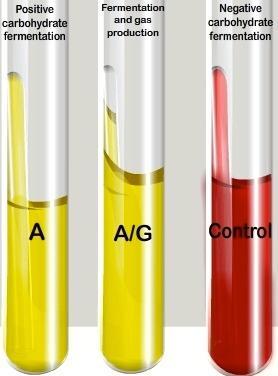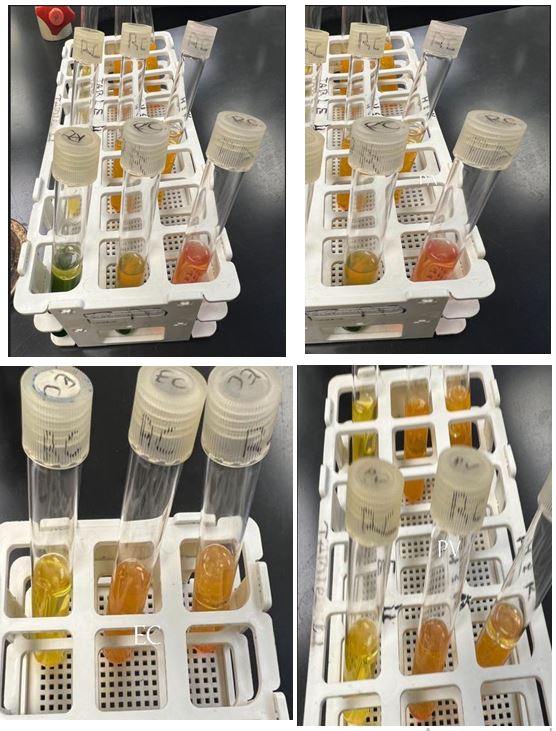Introduction
This experiment aims to determine the ability of microbes to ferment carbohydrates (glucose) with the production of an acid and/or gas. The researcher’s goal is to determine whether bacteria can ferment a specific carbohydrate by using the carbohydrate fermentation test. Various microbial groups or species can be distinguished from one another using their carbohydrate fermentation patterns. Mostly in the fermentation process of numerous carbohydrate feedstocks, various bacterial strains have been employed (Zhang et al., 2020). Escherichia coli and Enterobacter aerogenes, two frequently used enteric bacteria, can also be used to produce hydrogen through fermentation. It checks for the presence of any gas or acid that results from the carbohydrate fermentation process. This is accomplished by using a base medium containing a single carbohydrate source, such as glucose, lactose, sucrose, or any other carbohydrate (Islam et al., 2020). The medium also contains a pH indicator, which can be used to identify when the pH of the medium has decreased as a result of acid production.
Bacteria can use almost any sugar variant and oligosaccharide that exists in nature because they can import and absorb nutrients of sugars with various structural variations. For such uptake of sugars against concentration gradient gradients, bacteria possess membrane transport systems that are powered by ATP, the proton motive force, and the highly energetic glycolytic intermediate phosphoenolpyruvate (Jeckelmann & Erni, 2020) The wide variety of overlapping substrate-specificities and various uptake mechanisms enable microbes to adapt quickly to and colonize dynamic environments. Examples of such indicators include Andrade’s solution, bromocresol purple (BCP), bromothymol blue (BTB), and phenol red (Suresh et al 2021). Additionally, Durham tubes, tiny inverted tubes, are submerged in the medium to check for the production of the gas (hydrogen or carbon dioxide). Micro-organisms groups as well as species can be distinguished from one another based on their carbohydrate fermentation patterns; all members of the Enterobacteriaceae family are glucose fermenters (they can metabolize glucose anaerobically). Proteus Vulgaris (positive) and Proteus mirabilis are distinguished by maltose fermentation (negative). Only Neisseria meningitides (meningococci) ferments maltose, while Neisseria gonorrhoeae (gonococci) and meningococci both ferment glucose. It is possible to recognize Corynebacterium diphtheriae and other Corynebacterium species using rapid carbohydrate utilization tests (RCTs).
Bacteria can generate the energy they require to survive by fermenting carbohydrates. During glycolysis, the majority of microorganisms convert glucose to pyruvate; however, some species utilize alternative pathways. A fermentation medium is made up of a basal medium that is fermentable and contains just one type of carbohydrate (such as glucose, lactose, sucrose, mannitol, etc.). However, the medium may contain a variety of color indicators, including bromocresol purple (BCP), bromothymol blue (BTB), and phenol red. (Leifson’s, 2018). Each tube contains a Durham tube to catch gas produced by metabolism concerning a color indicator to identify the production of acid from fermentation. Differentiating between bacterial groups or species can be done using the carbohydrate fermentation patterns those various organisms exhibit.
Protease peptone, as well as beef extract, are two ingredients in Phenol Red Broth Base that give a variety of organisms the carbon and nitrogen they need for healthy growth. The osmotic equity of the medium is kept in check by sodium chloride ((Leifson’s, 2018)). When the pH is acidic, phenol red acts as a pH indicator by changing the color of the medium from red to yellow. When carbohydrates are added, their fermentation raises the pH of the medium, making it acidic, and gas formation occurs in Durham’s tubes. Because of their ability to ferment carbohydrates, all Enterobacteriaceae thrive in this medium. The production of mixed acids, particularly butyric acids, results in a pH color shift as well as a pungent, unpleasant smell coming from the culture medium frequently. The application of this test method includes the purpose of microorganism differentiation, it is advised to ascertain the fermentation reaction of carbohydrates, and it is also helpful for locating Gram-negative bacteria, particularly Enterobacteriaceae.
A versatile differential experiment medium called Phenol Red Broth is frequently used to distinguish gram-negative enteric bacteria. It includes one carbohydrate, a Durham tube, peptone, and phenol red (a pH indicator) (glucose, lactose, or sucrose). A pH signifier called phenol red changes color from fuchsia above a pH of 7.4 to yellow below pH 6.8 (Prabhu et al., 2020). When sugar is utilized by an organism, an acid byproduct is produced, which causes the media to turn yellow. If the organism can use the peptone but not the carbohydrate, ammonia is produced as a byproduct, which raises the pH of the medium and turns it fuchsia. When the organism can use the carbohydrate, a gas by-product may be produced (Mallick 2019). If so, It is a bubble of air. A gas byproduct could be created once the microbe is eligible to use the carbohydrate. If so, the Durham tube can become trapped in an air bubble gas is unlikely to be produced, and also no gas bubbles will form if the microbe is unable to digest the carbohydrate.
Materials
- Bunsen burner
- Pen marker
- Slides
- Microscope 4x, 10x, 40x, 100x
- Triple Sugar Iron Agar (sugars: Glucose 1x, Lactose 10x, Sucrose 10x, Thiosulfate, and Iron)
- Broth of slant/culture
- Needle
- Loop
- SIM AGAR
Methods
Four test tubes were washed and cleaned. Then, using a marker pen, they were labeled EC, EA, PV, and PA. To kill any existing microorganisms, the wire loop and needle were heated in the Bunsen burner. Each test tube was inoculated with microorganisms aseptically using an inoculating needle or loop. The test tubes were then incubated for 18-24 hours at 35-37°C. After 24 hours, color changes or gas formation were determined.
Results
Table 1: Showing Experimental Results


Discussion and Conclusion
When the experiment was conducted with Escherichia coli and Proteus vulgaris, acid was produced, indicated by a change in color from red to yellow after incubation. The presence of acid is accompanied by a drop in the pH as a result of carbohydrate fermentation. The observed bubble in the inverted Durham tube showed the production of gas. The bacteria also displayed good luxuriant growth since protease peptone and extract of extract ingredients in Phenol Red Broth base provided the specimen with the nitrogen and carbon required to grow healthily.
In replacing the first specimen, Escherichia coli and Proteus vulgaris, with Enterobacter aerogenes, no bubble was observed in the inverted Durham tube, indicating the absence of gas. Ideally, the specimen that is present in the media is an anaerobic organism. Meanwhile, the tube content remained red, showing the bacteria could not ferment the carbohydrate present in the media. Enterobacter aerogenes showed good luxuriant growth since protease peptone and beef extract ingredients in Phenol Red Broth Base provided enough nitrogen and carbon for growth.
Pseudomonas aeruginosa, no burble was observed in the inverted Durham tube, indicating the absence of gas. In addition, the content of the Durham tube remained red. Based on the results you described, it seems that this particular strain of Enterobacter aerogenes is unable to produce gas and ferment carbohydrates. This suggests that it is an anaerobic organism, which means that it does not require oxygen to survive and grow. The presence of protease peptone and beef extract in the Phenol Red Broth Base provided enough nitrogen and carbon for the bacteria to grow, but not enough for it to produce gas or ferment carbohydrates.
Conclusively, Escherichia coli and Proteus vulgaris are carbohydrate fermenters hence positive results were obtained while Enterobacter aerogenes and Pseudomonas aeruginosa acted as controls in the experiment since they are anaerogenic organisms. In the phenol red broth, however, all of the organisms survived and grew. This is because the protease peptone and beef extract ingredients in Phenol Red Broth Base provided the carbon and nitrogen that these organisms require for healthy growth. As seen in the experiment, all of the organisms were rod-shaped and gram-negative.
References
Baeyens, J., Zhang, H., Nie, J., Appels, L., Dewil, R., Ansart, R., & Deng, Y. (2020). Reviewing the potential of bio-hydrogen production by fermentation. Renewable and Sustainable Energy Reviews, 131, 110023. Web.
Islam, R., Hossain, M. N., Alam, M. K., Uddin, M. E., Rony, M. H., Imran, M. A., & Alam, M. F. (2020). Antibacterial activity of lactic acid bacteria and extraction of Bacteriocin protein. Advances in Bioscience and Biotechnology, 11(02), 49-59. Web.
Jeckelmann, J., & Erni, B. (2020). Transporters of glucose and other carbohydrates in bacteria. Pflügers Archiv – European Journal of Physiology, 472(9), 1129-1153. Web.
Leifson’s, O. F. (2018). Technical data sheet granuCult® prime of (oxidative/fermentative) medium (base) acc. Experimental Guide, Version 1-6. Web.
Mallick, M. N. (2019). Biochemical test of bacteria. Lab Guide, 1-34. Web.
Prabhu, A., Nandagopal M. S., G., Peralam Yegneswaran, P., Prabhu, V., Verma, U., & Mani, N. K. (2020). Thread-integrated smartphone imaging facilitates early turning point colorimetric assay for microbes. RSC Advances, 10(45), 26853-26861. Web.
Suresh, A., Nagda, D., & Abraham, J. (2021). Screening of biosurfactant-producing microorganisms from the soil. Scientific Study & Research on Chemistry & Chemical Engineering, Biotechnology, Food Industry, 22(4), 411-426. Web.